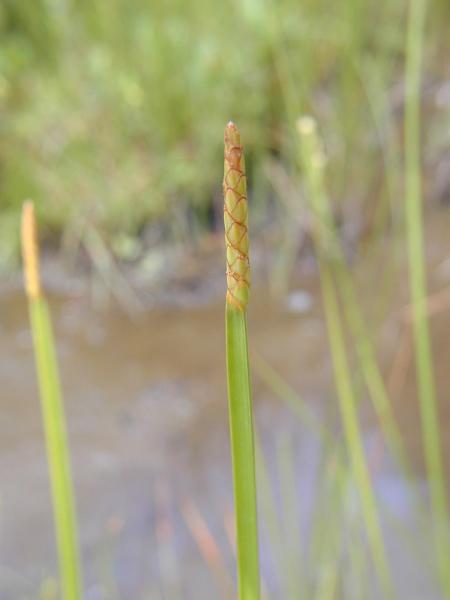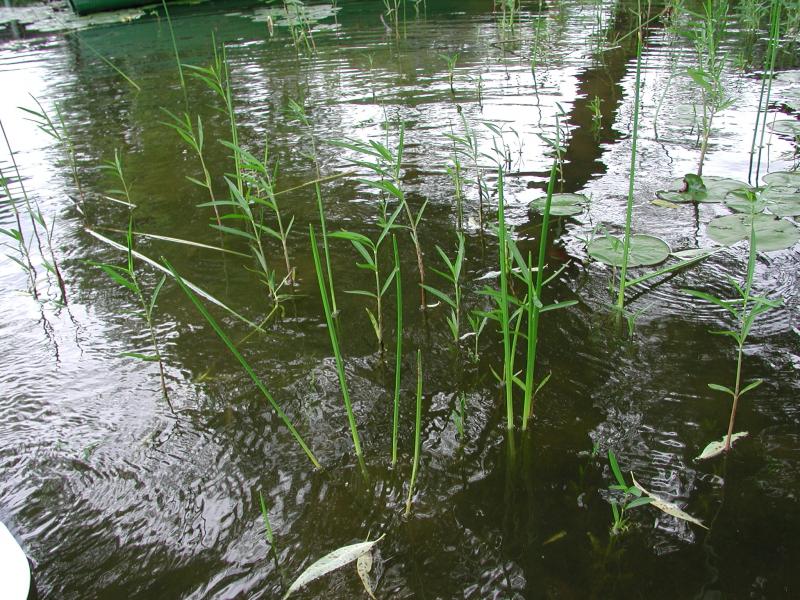Square-stemmed Spike Rush
Eleocharis quadrangulata (Michx.) Roemer & J.A. Schultes
- Class
- Monocotyledoneae (Monocots)
- Family
- Cyperaceae (Sedge Family)
- State Protection
- Endangered
Listed as Endangered by New York State: in imminent danger of extirpation in New York. For animals, taking, importation, transportation, or possession is prohibited, except under license or permit. For plants, removal or damage without the consent of the landowner is prohibited.
- Federal Protection
- Not Listed
- State Conservation Status Rank
- S1
Critically Imperiled in New York - Especially vulnerable to disappearing from New York due to extreme rarity or other factors; typically 5 or fewer populations or locations in New York, very few individuals, very restricted range, very few remaining acres (or miles of stream), and/or very steep declines.
- Global Conservation Status Rank
- G5
Secure globally - Common in the world; widespread and abundant (but may be rare in some parts of its range).
Summary
Did you know?
This is the only Eleocharis species in New York with a tall square stem, thus the species name. The genus name Eleocharis comes from the Greek "elos" for marsh and "charis" for grace. This and many other Eleocharis species are important wildlife food for wetland birds and other animals. You can often see damselflies and dragonflies perching on the tops of the stems.
State Ranking Justification
There are four existing populations but only one of them is large. The three other populations are small or threatened by development. There are about 10 historical populations, some of which need to be checked and some are considered extirpated.
Short-term Trends
The short term trend seems to be declining but more surveys are needed to determine this more accurately. One large population was in an area slated for development on Staten Island and other existing populations are in unprotected lakes.
Long-term Trends
This species has probably declined from historical populations since many of them exist in lakes in highly developed areas. There are about 10 historical localities which have been extirpated or not relocated in recent years although one population from 1938 was relocated in the late 1990s in Central New York.
Conservation and Management
Threats
Many of the ponds have water levels that are manipulated or have boat traffic that can threaten these plants. Shoreline development is a threat to one large population. European alder may also threaten one population.
Conservation Strategies and Management Practices
Keep shoreline plants from being destroyed by direct human development and by erosion from boat traffic.
Research Needs
More research could be done with techniques designed to augment populations at existing sites. We would also like to know what limits its distribution along shorelines.
Habitat
Habitat
In New York this species occurs on the mucky bottoms of two shallow, artificial ponds, and along the rocky shoreline of a lake. More information on its habitat requirements in New York is needed (New York Natural Heritage Program 2007). Pools and creeks (often tidal), chiefly of the Coastal Plain (Fernald 1970). Shallow water (Gleason & Cronquist 1991).
Associated Ecological Communities
- Coastal salt pond*
(guide)
A community inhabiting marine shoreline lakes or ponds formed by sandspits that close off a lagoon or bay. The water typically averages brackish or slightly brackish over long periods of time, but may range rapidly from fresh to saline.
- Farm pond/artificial pond
The aquatic community of a small pond constructed on agricultural or residential property. These ponds are often eutrophic, and may be stocked with panfish such as bluegill and yellow perch.
- Marl pond*
(guide)
The aquatic community of a small, shallow, spring-fed pond in which the water has a high concentration of calcium. The calcium precipitates out of the water as calcium carbonate and forms a marl sediment.
- Marl pond shore*
(guide)
The marly shore of an inland pond. Marl is a whitish substance that is deposited from water that has a lot of calcium dissolved in it. The whitish substance is calcium carbonate, people used to harvest marl to lime agricultural fields. Water levels of marl pond shores may fluctuate seasonally. There are usually only a few plants.
- Mine spoil wetland*
A sparsely vegetated wetland in which the substrate consists of mine spoils.
* probable association but not confirmed.
Associated Species
- Acer rubrum
- Alnus glutinosa (black alder, European alder)
- Cicuta bulbifera (bulb-bearing water-hemlock)
- Cladium mariscoides (twig-rush)
- Cornus amomum
- Cornus racemosa (gray dogwood, red-panicled dogwood)
- Decodon verticillatus (water-willow)
- Dichanthelium clandestinum (deer-tongue rosette grass)
- Eleocharis acicularis (needle spike-rush)
- Euthamia graminifolia (common flat-topped-goldenrod)
- Iris versicolor (blue flag)
- Juncus canadensis (Canada rush)
- Lemna
- Ludwigia palustris (water-purslane)
- Lycopus
- Myrica pensylvanica
- Persicaria amphibia
- Persicaria hydropiper (water-pepper)
- Phragmites
- Potamogeton amplifolius (big-leaved pondweed)
- Proserpinaca palustris (coastal marsh mermaid-weed)
- Rhynchospora alba (white beak sedge)
- Rosa palustris (swamp rose)
- Salix x pendulina
- Schoenoplectus americanus (chair-maker's bulrush)
- Sphagnum
- Spiraea tomentosa (steeplebush)
- Thelypteris palustris
- Triadenum virginicum
- Typha latifolia (wide-leaved cat-tail)
- Vaccinium macrocarpon (cranberry)
- Vitis
- Xyris
Range
New York State Distribution
The only known, extant populations of Eleocharis quandrangulata in New York are from Staten Island, Long Island, and a single population from a lake in Cayuga County. It has also been collected from the Lower Hudson Valley, and Oswego County in Western New York.
Global Distribution
Eleocharis quadrangulata reaches the northeastern edge of its range in Ontario, New York, and southern New England, is present in most of eastern US south as far as Florida, Texas and central Mexico, and through most of the Mississippi Valley to Wisconsin. There are disjunct populations in California and Oregon
Identification Comments
General Description
Spikerushes consist of a simple stem (the leaves bladeless and inconspicuous), with the infloresence a solitary, many-scaled spikelet at the top of the stem. The perianth (sepals and petals), if present, is reduced to bristles. The base of the style is expanded into a tubercle, and is usually persistent on the fruit (achenes). Eleocharis quadrangulata is perennial, from a rhizome. The stems are 30 to 105 cm tall, and, unique among spikerushes, are sharply 4-angled and spongy. The spikelet is about 2-7 cm long. The achenes are biconvex and finely reticulated (at 10 to 15x magnification), and are 1.8 to 3 mm long.
Best Life Stage for Proper Identification
This species is best identified with mature fruit, though it may be possible to identify it from its quadrangular stem.
Similar Species
The four-sided stesma are unique among New York Eleocharis species. Eleocharis equisetoides may appear superficially similar, but has a terete stem and is septate.
Best Time to See
Eleocharis quadrangulata flowers in July and fruits may be seen mid-July through to mid-October.
- Vegetative
- Fruiting
The time of year you would expect to find Square-stemmed Spike Rush vegetative and fruiting in New York.
Square-stemmed Spike Rush Images
Taxonomy
Square-stemmed Spike Rush
Eleocharis quadrangulata (Michx.) Roemer & J.A. Schultes
- Kingdom Plantae
- Phylum Anthophyta
- Class Monocotyledoneae
(Monocots)
- Order Cyperales
- Family Cyperaceae (Sedge Family)
- Order Cyperales
- Class Monocotyledoneae
(Monocots)
- Phylum Anthophyta
Additional Common Names
- Angled Spike Rush
Synonyms
- Eleocharis mutata (L.) Roemer & J.A. Schultes [in part.]
- Eleocharis quadrangulata var. crassior Fern.
Additional Resources
References
Borman, Susan, Robert Korth and Jo Temte. 1997. Through the Looking Glass. A Field Guide to Aquatic Plants. Wisconsin Lakes Partnership, University of Wisconsin - Stevens Point, Stevens Point, Wisconsin.
Crow, Garrett E. and C. Barre Hellquist. 2000. Aquatic and wetland plants of northeastern North America: A revised and enlarged edition or Norman C. Fassett's a manual of aquatic plants. Volume two angiosperms: Monocotyledons. The University of Wisconsin Press. Madison, Wisconsin. 456 pp.
Fernald, M.L. 1950. Gray's manual of botany. 8th edition. D. Van Nostrand, New York. 1632 pp.
Flora of North America Editorial Committee. 2002. Flora of North America, North of Mexico. Volume 23. Magnoliophyta: Commelinidae (in part): Cyperaceae. Oxford University Press, New York. 608 pp.
Gleason, Henry A. and A. Cronquist. 1991. Manual of Vascular Plants of Northeastern United States and Adjacent Canada. The New York Botanical Garden, Bronx, New York. 910 pp.
Holmgren, Noel. 1998. The Illustrated Companion to Gleason and Cronquist's Manual. Illustrations of the Vascular Plants of Northeastern United States and Adjacent Canada. The New York Botanical Garden, Bronx, New York.
New York Natural Heritage Program. 2010. Biotics database. New York Natural Heritage Program. New York State Department of Environmental Conservation. Albany, NY.
New York Natural Heritage Program. 2024. New York Natural Heritage Program Databases. Albany, NY.
Rhoads, Ann F. and Timothy A. Block. 2000. The Plants of Pennsylvania, an Illustrated Manual. University of Pennsylvania Press, Philadelphia, PA.
Voss, E.G. 1972. Michigan Flora, Part I. Gymnosperms and Monocots. Cranbrook Institute of Science Bulletin 55 and the University of Michigan Herbarium. Ann Arbor. 488 pp.
Weldy, T. and D. Werier. 2010. New York flora atlas. [S.M. Landry, K.N. Campbell, and L.D. Mabe (original application development), Florida Center for Community Design and Research http://www.fccdr.usf.edu/. University of South Florida http://www.usf.edu/]. New York Flora Association http://newyork.plantatlas.usf.edu/, Albany, New York
Weldy, Troy W. and David Werier. 2005. New York Flora Atlas. [S.M. Landry, K.N. Campbell, and L.D. Mabe (original application development), Florida Center for Community Design and Research. University of South Florida]. New York Flora Association, Albany, NY. Available on the web at (http://newyork.plantatlas.usf.edu/).
Links
About This Guide
Information for this guide was last updated on: January 18, 2008
Please cite this page as:
New York Natural Heritage Program. 2024.
Online Conservation Guide for
Eleocharis quadrangulata.
Available from: https://guides.nynhp.org/angled-spike-rush/.
Accessed July 26, 2024.

